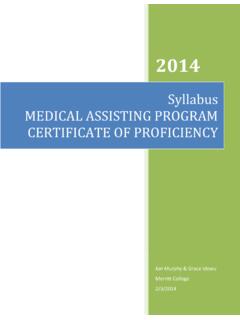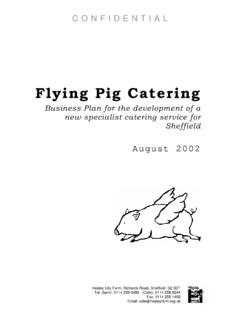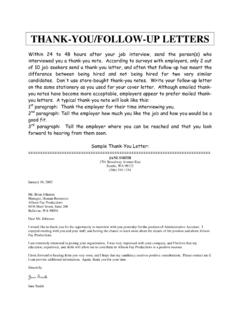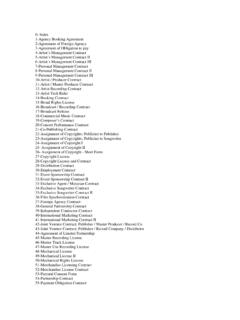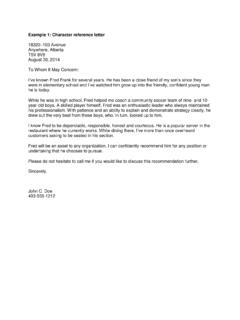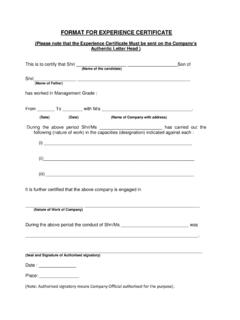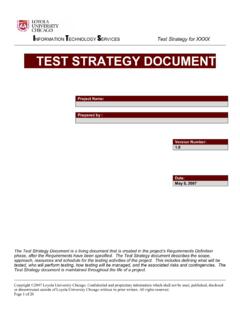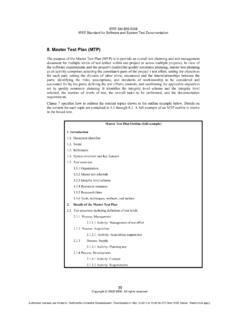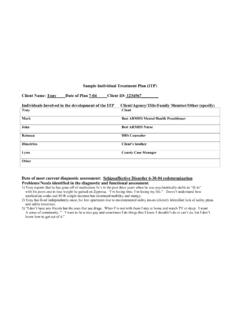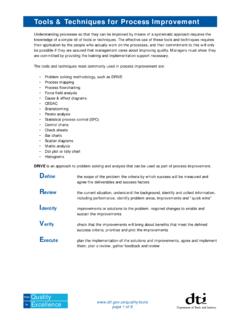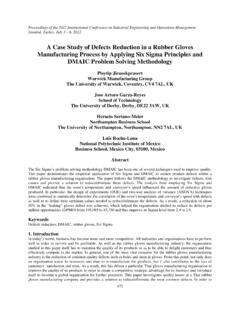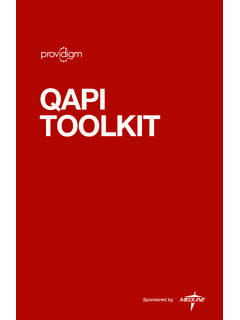Transcription of Six Sigma Project Charter
1 Rev 12. Six Sigma Project Charter Name of Project : Streamline Incomplete Applicant Follow-ups Black belt: Green belt: X. Submitted by: Emily Vazquez & Angela Love E-mail: & Date submitted: October 4, 2012. I. Project Selection Process Item Yes No Comments Key business issue x Linked to a define process x Customers identified x Applicants & Admissions Defects clearly defined x Describe how and why Project was selected. Reference any tools used, such as SIPOC, VOC plan, Affinity diagram, KANO model, CTS tree, etc . II. Project Description Project Title Streamline Incomplete Applicant Follow-ups Date Charted Target Completion Date Actual Completion Date 05/17/12. Project Leader Team Facilitator Team Champion Emily Vazquez & Pamela Horne Rebekkah Porter &. Angela Love Debra Emerson Estimated Cost Savings Actual Cost Savings Costs of implementing Project There is not really a cost savings.
2 It's more of an efficiency savings. Team members Emily Vazquez, Angela Love, Rebekkah Porter, Debra Emerson, Pamela Horne Problem Statement The current process of sending follow-up notifications to applicants, who have been incomplete for 45 days and 90 days, is a five-step process within three different computer systems. Each entry term (spring, summer and fall) must be ran individually, which adds to the amount of time it takes. Because it is so time consuming, what should be a daily task, has become a weekly one. Y = process time. Defect occurs when process time is 5+ steps. Project Goal and Metrics Stream line the follow-up procedure to improve/condense processing time. 1. rev 12. Describe the challenges and support required While on the quest to improve the current follow-up procedure, we are also challenged to learn the existing process (In short, we must learn it, so that we can change/improve it).
3 The Competency Center will be supporting our efforts in this Project . Project Schedule D1. Select the output characteristic. Date: Criteria: Is there a measurable output? Yes Is there a performance standard for the output? Yes Does variation currently exist? Yes Is there a process associated with the problem? Yes Is the solution unknown? Yes Y= process time It takes 3 hours to create/send letters. New Y= To take 1 hour or less to create/send letters. D2. Define the output performance standard. Date: We are concentrating on electronic emails. Processing notifications daily would alert the applicant sooner so the necessary information would arrive in the office quicker and the application would become complete. Therefore, saving future time dealing with each application and applicant. D3. Describe the process.
4 Date: Required tools: SIPOC, Detailed process map See attached SIPOC & RACI. M1. Validate the measuring system. Date: Required tools: Gage R&R/Attribute Agreement Analysis We are working as a team on this Project and we have discussed why we feel that we are on the same page many times. We are in agreement that we will track our measurement of time in the exact same manner. Our start time begins the minute we sit down to begin working on the process and our end time will be the point that we conclude the last step of the process. M2. Establish current process capability for the output. Date: Required tools: Process capability, Control chart What will we improve on? TIME. Due to the time restraints, we can't obtain enough data to complete this portion therefore we are providing a baseline. Time: 210 minutes / 135 Emails = Baseline 2.
5 Rev 12. M3. determine Project objectives. Date: A1. Identify and list all potential causes (inputs). Date: Required tools: Process map, Brainstorming, fishbone diagram, Cause and effect matrix, Potential X matrix See attached fishbone diagram A2. Screen potential causes. Date: Required tools: See A1. See attached Cause & Effect Matrix A3. determine the f(x) key input variable(s) Date: Required tools: One factor at a time experiment See attached Potential X Matrix I-1. Establish operating tolerances for key inputs and output. Date: In the quest to streamline incomplete applicant follow-ups, we are planning to use a Banner process that is actually designed to send emails based on a popsel, SOREMAL. This process will be more automated than the current process (saving time and therefore, money). Our Project is to investigate and build SOREMAL.
6 I-2. Re-evaluate the measuring system. Date: Required tools: Gage R&R/Attribute Agreement Analysis Because of the time crunch, we did not have enough time to gather more data. I-3. Establish final capability for key input(s) and the output. Date: Required tools: Process capability, Control chart The use of the SOREMAL email process is expected to become vital to our office as a means to communicate to our incomplete applicants in a more expeditious manner. The SOREMAL process will allow us to eliminate the preparation and manual emailing of these follow-ups. Our expectation is that SOREMAL will be an excellent communication tool that saves time. Instead of using the many steps from the previous process, it is our goal that the SOREMAL email process will use only 3 steps. C1. Implement process controls for the key inputs.
7 Date: Required tool: Four levels of control, error proofing The team members, who could also be some of the employees responsible for running the process in the future, gained access to PreProd, a software program for running real processes in a testing environment. We ran multiple tests to ensure the SOREMAL. process will function in a manner which to save time. The process results have been 3. rev 12. evaluated and documented for future reference as well as the process procedures. When we receive enough data in the real world, we will run the process in the live environment. Follow-up to ensure effectiveness. Date: We do not really have any follow-up activities other than to continue on with the new process to ensure that we are saving time. Black Belts must utilize the following additional tools: FMEA, hypothesis testing, regression, design of experiments, and one lean tool of their choice.
8 4. Six Sigma Project Submitted By: Emily Vazquez & Angela Love Step: D2. RUMBA Specification Checklist Write your specification here: Alert applicants of their incomplete applications sooner so they can send the necessary documents needed to complete their R Is the specification realistic? If not, write what needs to be changed to make the specification realistic: Yes, it is realistic. _____. U Is the specification understandable? If not, write what needs to be changed to make the specification understandable: Yes, it is understandable. _____. M Is the specification measurable? If not, write what needs to be changed to make the specification measurable: Yes, it is measurable. _____. B Is the specification believable? If not, write what needs to be changed to make the specification believable: Yes, it is A Is the specification attainable or achievable?
9 If not, write what needs to be changed to make the specification attainable or achievable: Yes, it is both attainable and Six Sigma Project Submitted By: Emily Vazquez & Angela Love Step: D3. Steps to Creating and Sending Incomplete Applicant Follow-up Letters The Office of Admissions sends follow-up emails (or postal mail letters) to applicants who have been incomplete for 45 days and 90 days. Each year, applications for the following calendar year become available on August 1. Follow-up emails/letters are created using the Banner letter generation process and we begin sending them 45 days into each Admissions cycle. Emails/letters are sent to incomplete applicants for all of the terms for which Admissions is currently admitting. So, initially, we are sending follow-ups to spring, summer, and fall incomplete applicants.
10 As the cycle progresses, we eventually stop sending emails to the spring term incompletes (because the term begins and it's no longer necessary) and continue to send them to summer and fall term incompletes until we reach the point where we are closing admission for those terms and it's no longer relevant to request missing information. 1. GLBDATA (Population Selection Extract) run the popsel to produce a list of PUIDs who meet the criteria of the popsel. 2. Use dropdown to choose Parameter Set, run letter generation jobs for selection ID WAD_FUP_1. (UG Adms Follow-Up 1). 3. Next Block 4. Submit & Save 5. Enter From_Date and To_Date 6. Enter Term (1. Spring, 2. Summer, 3. Fall) separately 7. Submit & Save 8. You will have a Sequence Number for the job that is running 9. Review Output if there are 0 results, you will simply rollback and repeat step #5, but with the next term.
